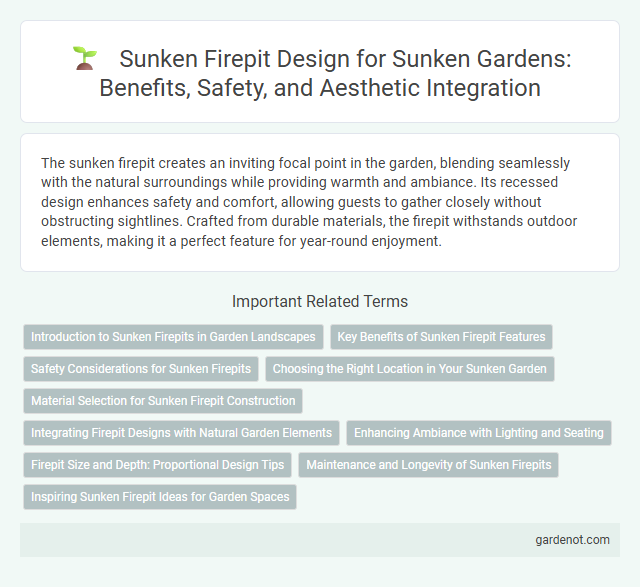The sunken firepit creates an inviting focal point in the garden, blending seamlessly with the natural surroundings while providing warmth and ambiance. Its recessed design enhances safety and comfort, allowing guests to gather closely without obstructing sightlines. Crafted from durable materials, the firepit withstands outdoor elements, making it a perfect feature for year-round enjoyment.
Introduction to Sunken Firepits in Garden Landscapes
Sunken firepits create a cozy focal point by integrating a fire feature below ground level in garden landscapes. These designs enhance safety by containing flames while providing warmth and ambiance for outdoor gatherings. Incorporating natural stone or brick materials complements the garden's aesthetics and improves durability.
Key Benefits of Sunken Firepit Features
Sunken firepits enhance outdoor spaces by creating a cozy, intimate atmosphere while providing superior wind protection for consistent flames. Their recessed design increases safety by containing sparks and reducing trip hazards compared to traditional firepits. Additionally, the deeper setup retains heat more efficiently, extending warmth and comfort during chilly evenings.
Safety Considerations for Sunken Firepits
Sunken firepits require careful attention to ventilation and materials to prevent hazardous smoke buildup and ensure safe airflow. Incorporating non-combustible liners such as stone or brick reduces fire risk while maintaining structural integrity. Proper placement away from flammable vegetation and installation of protective barriers are essential to minimize accidental injuries and enhance overall safety.
Choosing the Right Location in Your Sunken Garden
Selecting the ideal location for a sunken firepit in your sunken garden requires considering factors such as natural wind patterns, accessibility, and proximity to seating areas. Positioning the firepit on a level surface ensures safety and ease of use while enhancing the garden's aesthetic appeal. Incorporating surrounding plants that are fire-resistant and maintaining sufficient clearance from flammable structures optimize both safety and ambiance.
Material Selection for Sunken Firepit Construction
Choosing durable, heat-resistant materials like natural stone, fire-rated bricks, or concrete pavers ensures the longevity and safety of a sunken firepit. High-temperature refractory mortar or fireproof adhesive is essential for securing the structure and preventing cracks caused by thermal expansion. Incorporating materials with good thermal mass enhances heat retention, creating a cozy and efficient firepit environment.
Integrating Firepit Designs with Natural Garden Elements
Integrating sunken firepit designs with natural garden elements enhances outdoor aesthetics by blending stone, earth, and water features. Using materials like natural flagstone or river rocks creates seamless transitions that complement surrounding greenery and floral arrangements. Incorporating native plants and ambient lighting around the firepit further amplifies the organic feel, fostering a cozy and inviting atmosphere.
Enhancing Ambiance with Lighting and Seating
A sunken firepit transforms outdoor spaces by combining cozy seating with carefully designed lighting to create an inviting atmosphere. Strategically placed LED lights highlight the firepit's contours, enhancing both safety and visual appeal during evening gatherings. Surrounding the firepit with weather-resistant benches or cushioned seating encourages social interaction while optimizing comfort and ambiance.
Firepit Size and Depth: Proportional Design Tips
Optimal firepit size and depth in a sunken garden balance functionality and safety, with common dimensions ranging from 36 to 48 inches in diameter and 12 to 18 inches deep. Designing proportional firepits maintains airflow and heat distribution, preventing smoke buildup and ensuring a cozy ambiance. Selecting durable materials like stone or brick complements the sunken aesthetic while adhering to fire safety standards.
Maintenance and Longevity of Sunken Firepits
Proper maintenance of sunken firepits involves regular cleaning of ash and debris to prevent clogging and ensure efficient airflow. Using weather-resistant materials such as stone or metal enhances durability and reduces the risk of damage from moisture and rust. Applying a protective sealant and covering the firepit when not in use extends its lifespan by protecting it from harsh environmental conditions.
Inspiring Sunken Firepit Ideas for Garden Spaces
Inspiring sunken firepit ideas transform garden spaces into cozy, inviting retreats by blending natural stone seating with lush greenery for a seamless outdoor experience. Incorporating built-in benches and ambient lighting enhances comfort and creates a warm focal point perfect for gatherings. Strategic placement amidst flower beds or near water features amplifies the aesthetic appeal and promotes year-round usability.
Sunken firepit Infographic

 gardenot.com
gardenot.com